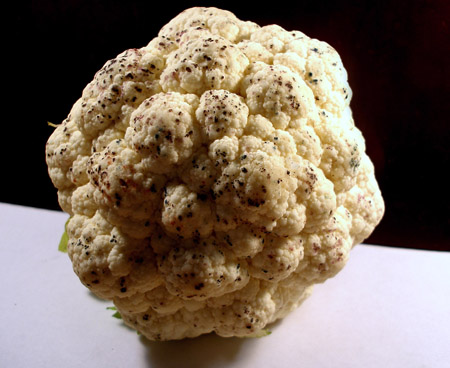Diseases
Pseudomonas syringae pv. maculicola (McCullorh)Young et al. - Bacterial Leaf Spot of Cauliflower.
Systematic position.
Kingdom Procaryotae, section Gram-negative aerobic rods and cocci, family Pseudomonadaceae, genus Pseudomonas.Synonyms.
Bacterium maculicolum McCulloch, B. maculicola (McCulloch) McCulloch, B.maccullochianum (McCulloch) Burgwitz, Phytomonas maculicola (McCulloch) Bergey et al., Ps. maculicola (McCulloch) Stevans.Biological group.
Hemibiotroph.Morphology and biology.
Bacteriosis attacks cotyledons, leaves, stems, peduncles, pods, and seeds. There are oily dark spots on cotyledons (they are better visible on the lower side of leaves). Adult plants have angular, slightly pressed, dark brown or violet (to black) spots with oily shade and semi-transparent limb. As a rule, leaves of strongly diseased plants are curtailed, turn yellow, dry up, and fall down. There are longitudinal black spots on the infected stems, sheet pedicles and flowers. Symptoms of the disease are shown as small gray-brown spots on inflorescences. On infected heads of cauliflower, there are dark-brown spots, which may embrace the head completely at high air humidity in 2-3 days. Infected heads quickly decay. Black blight spots are observed on pod valves, both on external and internal surfaces of the diseased plants. The bacterial infection passes from pods to seeds, which become black. Cells of Ps. syringae pv. maculicola are straight bacilli, moving by 1-5 flagella, usually 0.9 x 1.5-3.0 mkm. Gram-negative. Aerob. Forming a fluorescing pigment. On potato agar, colonies are round, brilliant, smooth, transparent in transmitted light, opalescent; later they become dirty-white with dense and raised center. Not curdling and peptonizing milk. Not restoring nitrates. Not forming N2S. Producing indole. Hydrolyzing starch poorly. Forming NH3. Utilizing glucose and saccharose with production of acid, but not utilizing lactose, maltose. The optimum temperature for growth is 24-25°C, maximum 29°C, minimum is lower than 0°C. The infection is kept on vegetation residues and seeds. The secondary infection penetrates into the plant through injuries and ostioles.Distribution.
Bacterial Leaf Spot of Cauliflower is present in many countries (the USA, Denmark, Finland, Bulgaria, the Great Britain, Italy, China, Taiwan, etc.) where this culture is growing. Bacteriosis is found in territories of the former Soviet Union.Ecology.
Increased humidity (90% and higher) and temperature (17-20°C) have a great importance for the bacteriosis development. Favorable weather conditions for pathogen of bacteriosis may provoke epiphytotics, which may destroy plantings of cauliflower. High severity of the disease is possible on seed shoots of late cabbage planting, if the second half of vegetation period is excessively rainy.Economic significance.
In addition to cauliflower, the pathogen attacks Brussels sprouts, and both white- and red-head cabbage. Yield losses depend on a cultivated variety and conditions of cultivation of plants. In Leningrad Region, the amount of cauliflower seeds infected by bacterial infection ranges from 2% to 35%, and affection of late-landed seed material affected by pathogen can reach 100% in some vegetation seasons under favorable conditions. In Lithuania, the amount of diseased plants is 17% to 33%. The affection of some varieties of cauliflower reaches 64% in conditions of Ukraine; as a result, the yield and quality of marketable heads and seeds are reduced. Control measures include optimal agriculture, maintenance of crop rotation, cultivation of relatively resistant varieties, careful removal of plant residues, separating seeds from shrunken grains, pesticide treatment of seeds before sowing, and treatment of plants by pesticides during vegetation period.Reference citations:
Akhatov A.K., Dzhalilov F.S., Beloshapkina O.O., Stroikov Yu.M. & Chizhov V.N. 2002. Protection of vegetable cultures in the closed ground (hand-book). Moscow: KMK, 464 p. (in Russian).Bilai V.I., Gvozdyak R.I., Kraev V.G., Ellanskaya I.A., Zirka T.I. & Muras V.A. 1988. Microorganisms are the pathogens of diseases of plants. Kiev: Naukova dumka, 552 p. (in Russian).
Chumakov A.E. & Vladimirskaya M.E., eds. 1972. Distribution of diseases of vegetable cultures in the closed ground (Methodical indications). Leningrad: VIR, 31 p. (in Russian).
Gerasimov B.A. & Osnitskaya E.A. 1961. Pests and diseases of vegetables. Moscow: Selkhozgiz. 536 p. (in Russian).
Gorlenko M.V. 1947. A survey of geographical distribution of bacterial plant diseases in the USSR. Byulleten. obshchestva ispytatelei prirody, otdelenie biologii 32 (2): 61-70 (in Russian).
Gorlenko M.V. 1966. Bacterial diseases of plants. Moscow: Vysshaya shkola, 291 p. (in Russian).
Izraelskii V.P., ed. 1960. Bacterial diseases of plants. Moscow: Gosudarstvennoe izdatelstvo selskokhozuaistvennoi literatuty, 468 p. (in Russian).
Pavlyushin V.A., ed. 2004. Bacterial diseases of cabbage and measures of their control. Methodical recommendations. St. Petersburg: VIZR, 56 p. (in Russian).
Puipene I. 1988. Resistance of some varieties of cabbage to bacterial diseases. In: Grigalune A., ed. Protection of fruit-vegetable cultures against diseases, pests and weeds at intensive technology of cultivation. Vilnius: Gosudarstvennyi agropromkomitet Litovskoi SSR, p. 59-60 (in Russian).
Shpaar D., Kleinkhempel G., Myuller G. & Naumann K. 1980. Bacterioses of cultural plants. Handbook. Moscow: Kolos, 143 p. (in Russian).
Sidorenko S.S. 1963. Bacteriosis of a cauliflower. Zashchita rastenii protiv vreditelei i boleznei 1: 41-43 (in Russian).
Vzorov V.I. 1938. Species and spreading of bacteriosis of agricultural plants in the Soviet Union. In: Borover S.Ya., ed. Byulleten Rostovskoi stantsii zashchity rastenii 9: 87-91 (in Russian).
Yagudin V.D. & Shklyar S.N. 1979. Bacterial diseases of plants. In: Izrail.skii V.P., ed. Moscow: Kolos, 288 p. (in Russian).
Zhavoronkova I.P. 1935. Bacteriosis of cauliflower. Zashchita rastenii 6: 116-119 (in Russian).


